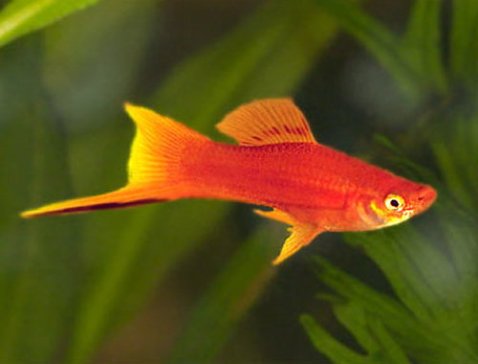The Swordtail fish (Xiphophorus hellerii)
Fish name: Xiphophorus hellerii
Common name: Swordtail
Maximum size (min-max): 10.0 – 12.0 cm ( 3.9 – 4.7 in)
pH of water: 7.0 – 8.0
Water hardness (dGH): dGH 12.0 – 18.0 N
Recommended temperature: 21.0 – 28.0 °C ( 69.8 – 82.4 °F)
Temperament to its family: peaceful
Temperament to other fish species: peaceful
Place in the aquarium: Top levels
The way of breeding: Live-bearer
Fish origin : Central America
Care: Easy

Body and sexual dimorphism
The male’s body is elongated with a sword in the adult age. The fish’s length with the sword is about 10-12 cm. The male’s sexual organ is called gonopodium. The name Swordfish was given according to this organ rather than as a part of the caudal fin. The female’s body is bigger than male’s and she is more robust than the male as well as not having any sword and gonopodium.
Colour variations
This tropical fish has some general colour variations. The wild form is olive green, with a red or brown lateral stripe and speckles on the dorsal and, sometimes, caudal fins. The male’s sword is yellow, the bottom edge is black. Just like other species, captive breeding of Swordtails has produced many colour varieties, including black, red, and lots of body patterns.
Feeding
You can feed them flakes, live-frozen worms and other food designed for tropical aquarium fish. Like all fishes, they need varied food. Especially, they need green foods which contain algae. You could install strong lighting in order to stimulate algae to grow in your tank thereby providing the Swordtails with what they demand and require as the basic food element. If you want to know if the fish are getting food of good quality, try to check their excrement. If the colour varies from green to black, then everything is fine. If you notice other colours, you could consider changing the food. Otherwise, your fish may face serious problems. If this is the case I recommend you simply change the food quality and amount.
Breeding the Swordtail fish
Firstly, the male fertilizes the female with the gonopodium. The male inserts his sperms into the female. Unusually though, the females are able to save some sperms for later fertilization. The fry grow in the female where they consume the yolk stores. The female’s pregnancy can be identified by the dark body in front of the anal fin.
Young swordtails are bigger than other fry of non live-bearer fishes. They immediately swim and can hide before predators. They also grow quickly and can eat flakes soon after birth.
Aquarium conditions and care
They need free space for swimming, however lots of aquarium plants too. For this fish, you need an aquarium with a minimum length of 1 metre. It means that an aquarium with a capacity of 200 litres or more is suitable for four specimens. For example, one male and 3 females. I don’t recommended you to keep 2 males in one tank. There is a hierarchy between Swordtails and only one male is the dominant one and could possibly harass the rest. If you keep the conditions inside the tank of a good quality, swordtails will become plentiful. Generally speaking, you will enjoy a lot of little swordtails specimens for months. Anyhow, it isn’t recommended to house them in the tank. You should give or sell them, otherwise you risk overpopulating your aquarium.
These fish are very good swimmers. If needed, they can swim very fast and can jump over the surface of the aquarium water. This is dangerous, since they can jump out. Naturally, they would die unless you put them back quickly. They’re good jumpers, because they become from streaming waters originally. Because of this reason, ensure a strong water stream in the aquarium. Swordtails and other live-bearers produce much excrement, so you should buy a good filtration system and clear the bottom from time to time.
They love hard water. Driftwood and peat can make water acidic. Swordtails can adapt to new conditions but probably won’t reproduce.
Common names, misspellings
Green Swordtail, Red Swordtail, Xiphophorus hellerihelleri, Poecilia helleri, Xiphophorus helleri, Xiphophorus helleribrevis, Xiphophorus helleristrigatus.
SURSA: www.aqua-fish.net

Ultimele comentarii